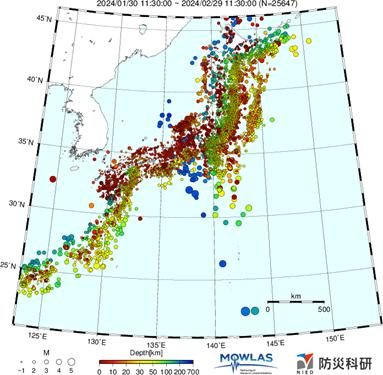Following the devastating 1995 Kobe earthquake, Japan significantly enhanced its disaster observation and response capabilities by establishing the Monitoring of Waves on Land and Seafloor (MOWLAS) network for improved earthquake, tsunami, and volcanic activity monitoring. Additionally, Shimizu Corp developed the Swing Mass Damper (SMD) for multi-directional seismic resistance in high-rise buildings. Fujitsu Ltd's Disaster Information Management System (DIMS) has been adopted domestically and internationally, optimizing disaster response through efficient data access and coordination. NHK utilizes artificial intelligence to broadcast disaster-related news in English, ensuring widespread dissemination of crucial information. These advancements collectively bolster Japan's disaster preparedness and response efforts.

Advanced technology: Earthquake, tsunami, volcano observation network
Immediately after the 1995 earthquake that caused widespread damage in Kobe, the National Research Institute for Earth Science and Disaster Resilience (NIED) created four nationwide land observation networks to improve monitoring and assessments of earthquakes, as well as estimating the likely impact of any tremors. Another network was added to the seabed off the east coast of Japan for the early detection of quakes and tsunami originating in the Pacific, linking up with another network off central Japan. Together, the networks are known as Monitoring of Waves on Land and Seafloor (MOWLAS). The networks use a range of seismometers that measure ground motion caused by an earthquake or changes in a volcano, even when the tremor is very small. That data is immediately analyzed to determine the scale of the threat and provides the authorities with the information required to make rapid responses.
Resistance of buildings
Private-sector companies are also committed to delivering products and services that are better prepared to resist disasters, such as the swing mass damper (SMD) control device developed by leading construction firm Shimizu Corp. The damper is designed to be installed on the roofs of ultra high-rise buildings to control complex, multi-directional shaking caused by a major earthquake. An improvement on conventional dampers, which are only able to match shaking in one direction, the equipment uses a steel or concrete counterweight supported by a frame fitted with two layers of laminated rubber bearings. The dampers can be retro-fitted to older buildings, stabilizing the movement of taller structures and making them less prone to collapsing.
Disaster management system adopted overseas
Information and communications technology giant Fujitsu Ltd has also perfected technology that has already been introduced overseas. The company’s Disaster Information Management System was previously adopted by the national and local governments across Japan, giving authorities instant access to data critical to a rapid and effective response to a natural disaster. That information includes early warnings and predictions of the scale of a disaster and areas that are most likely to be severely impacted. Receiving that information, authorities can build a better understanding of the most pressing needs and deploy assets optimally to save lives. Fujitsu delivered a tailored DIMS to Jakarta in 2013, giving the Indonesian capital an unprecedented ability to respond to looming disaster. The system soon proved its worth, coordinating responses to serious flooding in many parts of the city in January 2014.
Sharing information in foreign languages
NHK, Japan’s public media organization, has an unbeatable reach across the nation for news and is expanding the information it makes available in the event of a disaster. In May 2023, NHK started using artificial intelligence to read out English subtitles accompanying special news webcasts about disasters. The system is designed to operate when an earthquake with a seismic intensity of five or higher is detected, when a tsunami is imminent or if torrential rain is expected, or when the nationwide J-Alert is sounded.
Sources:
Reuters Plus
https://www.reuters.com/plus/japan-deploys-cutting-edge-technology-to-mitigate-natural-hazards .
Provided by the IKCEST Disaster Risk Reduction Knowledge Service System
Comment list ( 0 )
